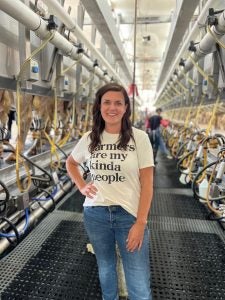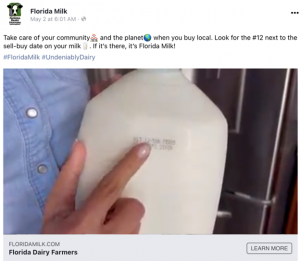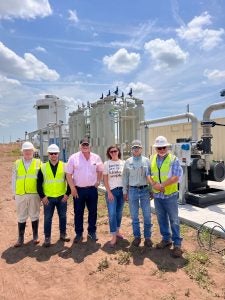“Sustainability” is likely the biggest buzzword these days within the food and corporate sectors. But what does it actually, mean and what is being done to improve it? The word is defined in the dictionary as “the ability to be maintained at a certain rate or level” or “avoidance or depletion of natural resources in order to maintain an ecological balance.”
Great, let’s dive in. Did you know that the dairy industry has pledged to be carbon neutral or better by the year 2050?
I toured a few dairy farms with “Florida Milk” to learn more about this — hands on and in person! This is Larson Farms of Okeechobee, Florida, where the three-generation Larson family has around 13,000 cows — a very impressive business that started in the 1940s.

There are 58 dairy farms in the state of Florida that are run by a total of 38 families, and you can tell if your milk is local by reading the number on the carton. If the number starts with 12, that means it’s Florida fresh!

In this instance, the Larson family’s farms are the closest dairies to 10 million residents of South Florida. But they don’t produce enough milk for everyone. The southeast produces 5 percent of milk production in the country (mostly fluid) but must also import milk from elsewhere. Actually, 75 percent of all dairy products come from the production of 25 percent of the farms across the U.S.!
There are a fair amount of myths out there with regards to the delicate ecosystem of Florida’s sandy soils near sea level: the Okeechobee region, the Everglades, and more. But a lot of negative media attention is usually outdated, or they’re not getting the full story. It’s important to go straight to the source and read the most recent peer-reviewed research. Huge efforts and improvements have been made to reduce phosphorus — through feed, fertilizer, manure management, and more — and the Okeechobee water management district has put numerous regulations in place to oversee many different environmental aspects.
We all care about the planet.
The Florida Department of Environmental Regulation created a dairy rule in 1989 that required every farmer to have a nutrient management Best Management Practices plan or they were given a stipend to relocate their cows to another state. Basically they’re required to stick to their plan to stay in business in Florida, or required to relocate if they don’t follow the environmental rules. It’s the only place in the country that requires this: Florida takes the environment very seriously, and the Everglades are a very hot topic. For reference, Marjory Stoneman Douglas was a very influential environmental extremist who had much influence in this discussion, which caused the state to lose over 25 percent of its dairies.
Florida farmers are required to operate under a lot of permits through the Florida Department of Environmental Protection. Nutrient balancing between feed, manure, milk production, and more are all overseen. Partner these environmental regs with the fact that dairy farmers are producing more with fewer resources, and you have a recipe for success.
Another cool piece of the sustainability puzzle? The Larson dairy also has an on-site methane digester, which captures the methane from the dairy and recycles it into fuel! That’s right, manure can fuel a bus. All recycled, renewable natural gas and energy straight from the farm.

There are of course pros and cons to different farm management systems, no matter whether they’re pasture raised or raised indoors in barns. Regardless, cows are fed very well-balanced diets with byproducts that we as humans can’t eat where it might end up in a landfill or left to waste. Some examples? Shells, rinds, pulps, stalks, rejected food (not “pretty” enough), fodder, and grasses!
Besides dairy, meat, lotions, cosmetics, textiles, musical and sporting goods, and more, cows are the ultimate upcyclers that turn “garbage” into products we use everyday — while protecting the environment in the process.
Michelle Miller, the Farm Babe, is a farmer, public speaker and writer who has worked for years with row crops, beef cattle, and sheep. She believes education is key in bridging the gap between farmers and consumers.



